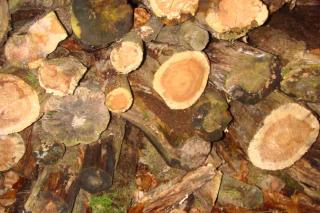

Wood as a source of energy is increasingly regarded as a natural solution for heating… and an antidote to rising fuel prices.
Did you know that about 30% of the surface of our country was covered in forests? Oil may be rare, but we’ve got wood in abundance!
On top of that, we now know how to use it in an economical and environment-friendly manner. To compensate surface area cut down and logged, forest nurseries plant millions of new trees every year, which means that amounts of CO2 released through burning for heating are theoretically compensated by new growth in young trees.
Since wood reserves replenish at rates over a million times faster than coal or petroleum, saying that wood is a “renewable resource” is definitely not a lie. Four cubic meters (or yards) of wood avoid using the equivalent of one ton of oil and avoids release of 1.5 tons of carbon dioxide!
 The first precaution when purchasing firewood is to check that it’s very dry. If there’s any moisture in the wood, not only will you be paying the price of that water (since it’s often sold by weight, and if by volume, wood tends to shrink as it dies), but it won’t burn as well and will clog the exhaust vent up. Wood needs to be dried for at least two years so that the moisture ratio may drop to a reasonable 20%. Even though the species influences combustion heat a lot, the most important factor is moisture levels in the firewood.
The first precaution when purchasing firewood is to check that it’s very dry. If there’s any moisture in the wood, not only will you be paying the price of that water (since it’s often sold by weight, and if by volume, wood tends to shrink as it dies), but it won’t burn as well and will clog the exhaust vent up. Wood needs to be dried for at least two years so that the moisture ratio may drop to a reasonable 20%. Even though the species influences combustion heat a lot, the most important factor is moisture levels in the firewood.
How can you tell? Simple: grab a couple logs and hit them together. If they ring with a sharp sound, the wood is ready for burning. If it’s a heavy thud, then they’re not yet ready. But the surest way to verify that it’s dry enough is to use a hygrometer or moisture sensor.
When you’ve brought your wood home or had it delivered, store your wood in a dry spot without any moisture: under a tarpaulin or in an outdoor shed, or better yet in a cellar, attic or well-ventilated garage.
Best, hands down, are deciduous hardwood trees (oak, ash, beech, walnut, hornbeam, fruit trees…), which are better than softwood trees (birch, poplar…) which tend to burn much faster. Buy only “firewood” certified wood, and don’t burn pallets or construction wood, which tend to be full of toxic chemicals. Conifers produce a lot of soot as they burn, and can clog the exhaust tubing with deposits that fuels chimney fires.
It’s wise to have the smoke vent or tubing swept once a year, or even two if it’s your only source of heating. Also, remember to purchase a smoke detector: it’s often mandatory in local regulations.
Pierrick the gardener